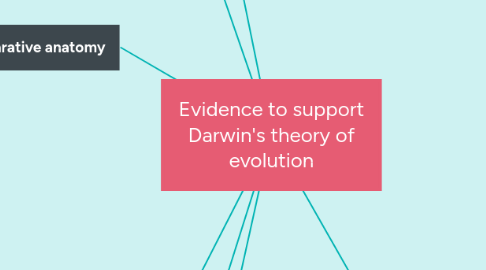
1. Fossil evidence
1.1. evidence in rocks show life on earth thats been developed from common ancestors
1.2. development of organisms can be traced
1.2.1. eg. human evolution
1.2.1.1. fossilised jaw and teeth found that are estimated to be up to 194,000 years old, making it at least 50,000 years older than modern human fossils
1.3. used to compare the ages of fossils across locations
1.3.1. helps scientists reconstruct the evolutionary histories of present-day species
2. DNA comparisons
2.1. Can extract the DNA from cells and compare the genetic information of two organisms
2.2. When one base in a sequence is a replaced in another, the DNA’s are being substituted.
2.2.1. more DNA differences in homologous genes between 2 species show how distant their species are from each other
2.3. Mapping the human genome and genomes of other organisms
2.3.1. shows links between different organisms
2.4. when the human gene that causes Parkinson’s disease is inserted into a fruit fly, = fly develops a disease. shows that fruit flies can be used to test treatments for Parkinson’s disease in humans.
2.5. DNA copied= small errors= modified dna codes
2.5.1. DNA mutation creating variations between organisms
3. Biogeography
3.1. global distribution of organisms and the unique features of island species reflect evolution and geological change
3.2. movement of tectonic plates over many years
3.2.1. groupingsof organisms that had already evolved before the breakup of the supercontinent Pangaea was later distributed worldwide.
3.3. Australia's marsupial types are diverse because Australia was isolated by water for many years
3.3.1. were able to evolve without competition from other mammals
4. Galapogas
4.1. Believed to be a certain type of population between finches but were variations between some
4.2. island environments favoured specific traits over others.
4.2.1. Known as 'Selection pressures'
4.2.2. those with favoured traits would survive
4.2.2.1. because of reproduction, in the future, there would be more finches with the favoured trait
4.2.3. those that didn't inhabit traits would die because theyre not fit for the environment
4.3. Isolation increased = interbreeding became more common = new species
5. Comparative anatomy
5.1. Comparing ancient and modern day species in an observatory way gives valuable info
5.2. highly modified mammal nose from ancient 4 legged mammals, same bone structures as mammals
5.2.1. Whale and hippos are linked
5.2.1.1. (ankles) (multichambered stomach) (missing coat of fur) (internal testicles)
5.3. tiny bones found in whales, leftovers from evolutionary history
5.4. if 2 or more species have the same type of bone (unique), theyve inherited the feature from a common ancestor
5.4.1. "homologus"
5.4.1.1. shows the developmental variations that existed in their last common ancestor.
5.5. -similar structures wouldn’t have been able to evolve on its own in each species
5.5.1. the basic layout of bones was already present in a common ancestor of whales, humans, dogs, and birds
5.6. some physical similarities are analogous
5.6.1. they evolved independently in different organisms because the organisms lived in similar environments/ selective pressures.
5.6.2. analogous structures show that similar selective pressures can produce similar adaptations
6. Embryology
6.1. study of creatures developing from being born to hatching out of an egg
6.1.1. shows that whales used to be a four legged mammal
7. General info
7.1. There's a common ancestor or group of organisms we all come from
7.1.1. NOT ORIGINATED FROM
7.1.2. branching tree
7.2. Evolution- any change in the heritable traits within a population over generations
7.2.1. Species changing and having it rise onto future generations
7.3. reproduction with variation = diversity
7.4. evolution is powered by natural processes
7.5. predicted power of evolution, nested hierachies of traits
7.5.1. eg. Cetaceans of the world (Whales, dolphins etc)
7.6. macroevolution
7.6.1. large-scale changes that occur over extended time periods
7.7. microevolution
7.7.1. small-scale changes that affect a few genes and happen over shorter timescales
7.8. all living organisms share
7.8.1. same DNA
7.8.2. highly similar genetic codes
7.8.3. basic process of gene expression
8. "All life on earth is connected and related to each other"
9. Gene pools and mutation
9.1. different genes form a gene pool
9.1.1. mutation and natural selection affect gene pools
9.2. Tracking the mutation rates in DNA provides good support
9.3. genes encode different biological/ behavioural traits = how genes are passed down from parents to offspring,
9.3.1. humans, cows, chickens, and chimpanzees all have a gene that encodes the hormone insulin
9.3.1.1. therefore gene was already present in their last common ancestor
9.4. mutations do nothing or are harmful but some are beneficial to certain organisms
9.4.1. it could become more prevalent for future generations and spread throughout that population
